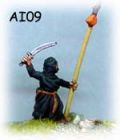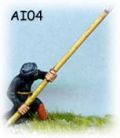Taifa Andalusian
The origins of the Taifa Kingdoms lies in the division of the Umayyad Caliphate of Córdoba into a series of ethnic (Arabs, Berbers, Iberian Muslims and Eastern European former slaves), cultural, administrative and political entities after the abolition of the caliphate in 1031.
Reversing the trend of the Umayyad period, when the Christian kingdoms of the north often had to pay tribute to the Caliph, the disintegration of the Caliphate left the rival Muslim kingdoms much weaker than their Christian counterparts, particularly the Castilian-Leonese monarchy, and had to submit to them, paying tributes known as parias.
Due to their military weakness, taifa princes appealed for North African warriors to come fight Christian kings on two occasions. The Fanatic Berbers were invited after the fall of Toledo (1085), and the Almohads after the fall of Lisbon (1147). These warriors did not in fact help the taifa emirs but rather annexed their lands to their own North African empires.
Taifas often hired Christian mercenaries to fight neighbouring realms (both Christian and Muslim). The most dynamic taifa, which conquered most of its neighbours before the Almoravid invasion, was Seville. Zaragoza was also very powerful and expansive, but inhibited by the neighbour Christian states of the Pyrenees. Zaragoza, Toledo, and Badajoz had previously been the border military districts of the Caliphate.
Seville
The kingdom started as a small, weakly defended territory comprising parts of current Spanish provinces of Seville, Huelva and Cadiz, but quickly emerged as the most powerful taifa kingdom of the time, after its rulers began pursuing a policy of expansion. After several military campaigns, the kingdom achieved dominance over all of Western Andalusia and Murcia. The kingdom reached its largest territorial extent in 1078 with the capture of Murcia in 1078 by poet Abu Bakr Ibn Ammar. Nevertheless, the Abbad family was still subject to taxation by the King of Castile, to whom they were vassals. The drain of these taxes weakened the kingdom's power: Al-Mu'tamid decision to stop paying these taxes caused King Alfonso VI (who had already conquered Toledo in 1085) to besiege Seville. Al-Mu'tamid asked help to the Almoravids of Morocco against the Castillan king. The Africans established themselves at Algeciras, and after defeating the Christians occupied all the Islamic taifas, included, in 1091, Seville itself. Ooops!
Valencia
The Taifa of Valencia was a medieval taifa kingdom which existed in four distinct periods: from 1010 to 1065, from 1075 to 1099, from 1145 to 1147 and last from 1229 to 1238 when it was finally conquered by Aragon.
From 1094 to 1099 the kingdom was also famously subject to the rule of legendary military leader El Cid.
Murcia
After the fall of the Caliphate of Cordoba in 1031, Murcia passed successively under the rule of AlmerÃa, Toledo and Seville. In 1172 it was taken by the Fanatic Berbers, and from 1223 to 1243 it became the capital of an independent kingdom.
Zaragoza
From 1018–1038, the city was ruled by the Banu Tujibi. They were replaced by the Banu Hud, who had to deal with a complicated alliance with El Cid of Valencia and his Castilian Masters against the Fanatic Berbers who managed to bring the Taifas Emirates under their control. After the death of El Cid his kingdom was overrun by Almoravids and by 1100 Fanatic Berbers had managed to cross the Ebro into Barbastro, which brought Aragon into direct contact with Fanatic Berbers, The Banu Hud stubbornly resisted Fanatic Berbers and ruled until they were eventually defeated by the Almoravids in May 1110. The last sultan of the Banu Hud, Abd-al-Malik Imad ad-Dawla, the last king of Zaragoza, forced to abandon his capital, allied himself with the Christian Aragonese under Alfonso I el Batallador and from the time the Muslims of Zaragoza became military regulars within the Aragonese forces.
El Cid
El Cid was born circa 1040. He fought for everyone, and was quite good at it.
Using the army in FoG
- It doesn't look that great - the El Cid mercenaries are almost a must have
- Don't rely on protected spear to do much for you against any half decent opposition
- Lots of Lh and a lot of skirmishing is another way to go
- Just put each new suggestion on a new line, starting with an "*"
Tournament Results with this army
Have a look for them on the Official FoG Database on the FoG site
Useful Links
User-contributed links about this army:
- El Cid - The Film on imdb
- Confraternity of the Knights of Santiago Scans of a historic book with (contemporary) colour drawings of knights from 400 years of Spanish chivalry and heraldry
- put the link text readers will see in here write some more detail about the link here
Allies
- Fanatic Berber - Some tidy superior spearmen, and 4d more lancers, but hard to make it work with just one General.
Painting and Collecting the Army
- Paint schemes, insignia, shield designs? Put it here.
15mm Manufacturers supplying figures for this army
You can see some of the figures in the Ancients Photo Gallery also on this site. This listing only covers "arabic" figures. For El Cid see any knightly army of this era

|
|

|

|
- Essex Miniatures - many generic Arabs, possibly too generic for todays tastes
- Donnington - 35+ arabs
- Museum Miniatures - several nice Arab/Persian/Turkish ranges, often using the same figures in each!
- Gladiator Miniatures by Fighting 15's (Previously Black Hat) 33-strong Crusades Moslems Range
- Old Glory 15's, several Arab Ranges
- Minifigs Venerable Crusader range with Arabs
- Irregular Miniatures 39 Arab & Turk figures from a generic range
- Lancashire Games - Several large "value" packs of Arab troops
- LKM Direct - Freikorps ranges have Medieval Turks
- Tin Soldier 16 Arabs in one range
- Outpost Wargame Services A specialist in this period/region, 30+ Crusade-period Islamics
- East Riding Miniatures Some berbers in a small El Cid Range may be suitable
- Khurasan Miniatures again a specialist period for Khurasan, with several Persian/eastern ranges
- Falcon Figures Ottoman range
- Battle Line Miniatures 27 Generic Arabs
- Eureka - Australian Site Grumpys Miniatures Persian & Afghan Ranges are quite fun
- 50 Paces.com their website shows an "Arab" range, but no figure codes listed
- Viking Forge - Arab Conquest Range
- Camelot Games Italian-based supplier with 10 Arabs
- Legio Heroica 22 Crusades-era Arabs
Army Lists
Sample army lists for this army
Name of Army / Date
A Taifa of Murcia, 1149AD army used at Warfare in the UK:
- 4 TCs
- 4 BGs 6 av LF bow
- 6 BGs 4 av LH javs, LS
- 2 BGs, 8 protected HF av DS (1 drilled, 1 undrilled)
- 2 BGs, 4 armoured superior knights
- 8 undrilled protected superior MF, off sp
- 4 drilled armoured MF, av, LS, Sw
It did well against the in period opponents (themed to avoid HA knights)
Remember to leave a line before you copy the above section as a template for your own list
eBay Listings
UK Bookstore